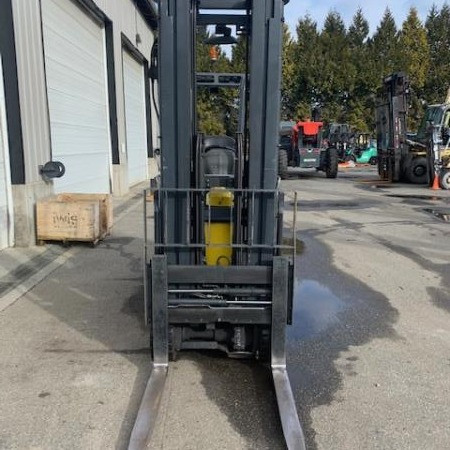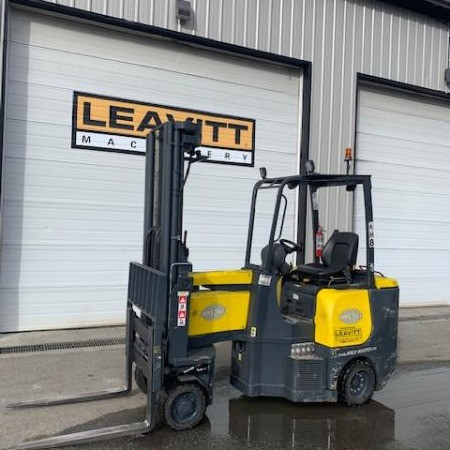Very Narrow Aisle Forklift Chula Vista
Used Very Narrow Aisle Forklift Chula Vista - Getting items from one warehouse location to another and to and from the loading docks is the focus of warehousing. Focus is often on space saving tools and the layout of the building. Extremely narrow aisles offer more storage space since there is less space needed for aisle access. Warehouse optimization consists of warehouse configurations.
Warehouse Optimization
There are several significant benefits of implementing very narrow aisle warehouse optimization.
Because very narrow forklift trucks were developed to take up less space in maneuvering, it is now possible to decrease warehouse aisle width to less than half the width required by standard forklifts. Certain models of very narrow aisle forklifts can increase the square foot storage capabilities by delivering greater stacking heights. This means that costs are decreased because less warehouse space is necessary for the same amount of stock than if a standard aisle configuration were used. In most urban areas where square footage is very costly, this is a huge benefit to warehouse operations. When planned carefully and properly, it is possible to increase warehouse storage area by up to 80 percent by implementing a very narrow aisle width configuration. In addition, a very narrow aisle layout allows for more rack faces as well as better access to products. Since greater quantities of products are situated in a more accessible area, there is less travel time needed for gathering and storing items.
It is common for warehouses to use a very narrow or narrow aisle layout. Narrow aisles are usually those that use less than 11 feet of aisle width. Very narrow aisles reduce the aisle width further to around six-and-a-half feet. Either of these widths drastically increases storage potential. Standard forklifts can have issues with turning in these aisle widths. A variety of very narrow forklifts have been designed to easily maneuver in narrow aisles.
Before choosing a forklift for a particular job, it is vital to know the dimensions of the aisle. Taking note of the proper dimensions will save valuable time and money by avoiding the mistake of acquiring a forklift that will not work in the intended application. Finally, it is critical that any utilities, posts or columns are taken into account before settling on a specific narrow aisle forklift design as these may affect access to aisles by some forklifts or prevent warehouse optimization.
Very Narrow Aisle Forklift Trucks
Rechargeable batteries are typical for powering very narrow aisle forklift trucks and most models are electric. Stand-up riders are a popular design for very narrow aisle forklift trucks. The most popular kinds of very narrow aisle forklift trucks include turret or swing-mast, end-control riders, order pickers and reach trucks.
Reach Forklift Trucks
Developed as a kind of rider stacker forklift, the reach forklift trucks can be configured for narrow aisle locations. This machine earned its name by its ability to reach its forks to secure a load. The moving mast and the moving carriage are two types of reach trucks. The moving carriage works by raising and lowering the carriage and the driver. The moving mast raises and lowers the forks as the operator remains at ground level. Of the two kinds of reach trucks, the moving mast reach truck is the safer of the two varieties. These machines rely on a kind of jointed framework known as a pantograph system that enables the operator to place a load or reach the load without moving the machine.
Order Pickers
Order pickers have been created to pick items from difficult, high racking systems. These machines are used for picking up lighter stock that can be moved by hand. Order pickers elevate the operator to the level of goods to pick and identify particular items required for filling an order.
End-Control Riders
End-control riders are used to pick loads located at floor level and transport the load horizontally, rather than lift or lower loads from various heights.
Turret or Swing-Mast Forklift
The turret or swing mast very narrow aisle forklifts have a swivel mast that pivots and articulates. The mast swivels to enable pallets to be positioned on the right or left side of the forklift.
Guided Very Narrow Aisle Trucks
Many very narrow aisle forklift trucks are able to be guided down aisles by wire or rail.
Because the forklift is guided, thereby reducing the possibility of the forklift bumping racks while moving down the aisle, the aisles can be extremely narrow. For rail-guided systems, a series of rails are installed into the floor, on both sides of the aisle, and run along the floor for the length of the aisle, curving around the end of the aisle. Specific wheel guides are on the forklift. These slide into the rails to stop the forklift from moving out of the rail guards.
Wire-guidance forklift systems install wires on the floor instead of rails and the wires run down the middle of the aisle. Narrow aisle forklifts rely on a wire-guide system to help it communicate with the floor wires. This allows the machine to be steered by the wires, stopping it from traveling outside of the specific location.
Work Site Considerations
Certain essential considerations need to be dealt with before using a narrow aisle configuration. Because these very narrow aisle configurations include very tall racking systems, the condition of the floor and the construction of the racks must be done properly in order to avoid potentially disastrous outcomes. There are four areas which must be meticulously prepared before setting up a racking system and must be continuously monitored and maintained throughout the operation of the warehousing system:
1. The floor must be level;
2. Cracks must be repaired;
3. Load capacity of floor must be appropriate; and
4. The racks must be plumb.
Level Floor
Due to the racking system height, any minor floor slope can gravely impact how plumb the racks are, particularly over time if loads are placed and removed repeatedly on the racks. The height of the racking system means that any minute floor slope can have a negative impact on how straight the racks are, especially over time when loads are continually removed and placed on the racks. A level floor is vital for the safety and integrity of the operator, employees, stock and the warehouse.
Crack Repair
When there are floor cracks found, they need to be assessed and immediately fixed for safety concerns. Cracks may affect the floor’s level and, when they are approximately 3/8 inches wide, will need to be properly filled with a material at least as hard as the surrounding floor.
Floor Load Capacity
Minimum flooring requirements must be met before considering a narrow aisle installation. Minimum flooring requirements include concrete measuring three thousand psi and rebar distributed evenly three to four inches below the surface. Extra reinforcements might be needed depending on the load requirements and the configuration.
Plumb Racks
Of great importance is the proper installation of the racking system. If installed improperly, there is a great chance of rack failure. All racks need to be plumb and this is one of the most vital aspects of correct installation. Rack shims are recommended to make sure the racks are plumb within one inch at the thirty- foot rack height.
Dangerous racking failure can occur if the above steps are not taken. Employees can become hurt or killed in the event that racking failure occurs. Goods can be damaged along with forklifts and other equipment. Due to these potential problems, the most significant part of creating a narrow aisle configuration for warehousing optimization is the initial measurements.
Very Narrow Aisle Forklift PDF
Stock Number: 209213 GL
Make: AISLEMASTER
Model: 44SE
Year: 2015
Price: $15,500
| Stock Number |
209213 GL |
| Make |
AISLEMASTER |
| Model |
44SE |
| Year |
2015 |
| Category |
Very Narrow Aisle Forklift |
Stock Number: 208758 GL
Make: AISLEMASTER
Model: 44SE
Year: 2015
Price: $20,500
| Stock Number |
208758 GL |
| Make |
AISLEMASTER |
| Model |
44SE |
| Year |
2015 |
| Category |
Very Narrow Aisle Forklift |
Stock Number: 207213 GL
Make: AISLEMASTER
Model: 44E
Year: 2013
Price: $21,000
| Stock Number |
207213 GL |
| Make |
AISLEMASTER |
| Model |
44E |
| Year |
2013 |
| Category |
Very Narrow Aisle Forklift |













